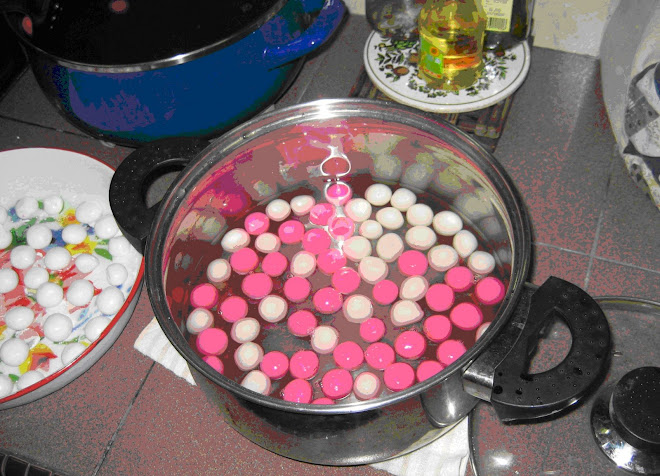Itik Tim soup here consists of salty duck pieces with preserved salted mustard leaves. My grandmother does a fabulous Teo Chew version of this preserved vegetable and duck soup for my father (but with leftover roast duck, salted mustard, fresh mustard, dried whole chillies, tamarind peel and tomatoes). It’s his favourite soup and he can drink gallons of this rich, hot, sour and salty broth.

(our dinner at Anak Nyonya Restoran)
The cubes of spongy-looking custard is otak otak Melaka-style. The otak otak I’m used to are usually wrapped up in banana leaves and either steamed or grilled. These cubes were an onslaught of flavours, chilli, turmeric and kaffir lime leaves punch through and the texture was a good mixture of smooth and slightly coarse fish meal. Think spicy fish mousse for those of you who haven’t yet tried it.
Ayam masak merah or red chilli chicken is a favourite dish with many Malaysians, and is usually eaten with mounds of rice. This version had some fiery chilli heat for extra kick. The sauce was very rich and had an almost caramelized/treacley consistency.
Cincaluk omelette is another popular Nyonya dish. Fermented tiny shrimps are beaten into the egg mix and shallow-fried – the texture is springy and very light. Delicious!
Our last dish, chap chye is a typical vegetarian dish you’ll find in many households on the first and fifteenth days of the month. Devout Buddhists observe vegetarian days on the first and fifteenth days of the month and this dish features heavily on the menu. It’s a comforting dish of braised cabbage, wood ear fungus, lily buds, mung bean vermicelli and bean curd skin.
Here are other food ramblings in Melaka town.
The Jonker Street markets offer a mix of touristy offerings and locally-made products. You’ll find this gentleman who runs a mobile popiah stall at the markets. Popiah fillings can be as economical or as luxurious as you want. Typical fillings consist of shredded yam bean, carrots, firm bean curd, pork and a heap of shallots and finely shredded lettuce. Some more upmarket popiah makers fill their thin skin wrappers with crab and other such indulgent fillings!

This Jonker Street Market popiah seller’s fillings (from memory) were very tasty despite lacking in luxurious ingredients, and made extra tasty by a dash of hoisin and chilli sauce. The guy handled dirty notes and coins – all the while preparing these parcels! Maybe that’s why they tasted so good!
Here is another memorable meal. Lunch at Hoe Kee for Melaka’s famous chicken rice balls. Imagine Hainan chicken rice packed up and rolled in giant golf ball-sized morsels. Call me boring but I think I preferred the normal chicken rice. The chicken was super smooth and tender and the accompanying sticky soy and gingery chilli sauce went down a treat. I didn’t think I’d get excited about cabbage but the stir-fried cabbage here is the goods! I could’ve eaten a whole plate of it if I weren’t with other people and had to share!

The soup was very tasty if you can get past the chopped up bits of chicken feet. Boil pork bones, black beans (also called turtle beans), ginger and lots of chicken feet for hours and you have a really tasty broth. My grandmother makes a version of black bean soup but with lamb shanks, ginger and honey dates. This makes the perfect winter pick-me-up.

(Hainan chicken rice balls in close up)
Melaka is a touristy town but with a bit of heart and soul and we had a great time walking around town looking at the old Chinese shop houses with their intricate carvings and plasterwork. The hotel we stayed at, Hotel Puri is a beautiful space to relax in. It’s a heritage Nyonya house with lots of interesting nooks and crannies filled with antique artifacts, kitchen and cooking utensils.
Here is a demonstration setup of a typical old-fashioned Malay kuih-making kitchen. !


(Such interesting kuih moulds)
The hotel is so ambient and relaxing even the swallows have found their way in and made comfortable homes in one of the foyers! It’s the most magical thing to walk into this room in the late evening and have these birds fly in and out encircling the room in search of a perch stop. The concierge told us that the owner of the hotel harvests the birds’ nests for soups every now and again. Birds nest can costs up to several thousand ringgit per kilo so this is a good omen indeed! There is a huge market for birds nest we discovered in Malaysia’s east coast (post of this later down the track!).


(There must be several generations of birds in the one room - oh the noise!)
Restaurants featured are:
Anak Nyonya Restoran, 88 Jalan Tokong, Melaka (closed Wednesdays) from 10:30am - 9:30pm
Hoe Kee Hainanese Chicken Rice Ball, 4-8 Jalan Hang Jebat, Melaka
Jonker Street night markets from 6pm - 12 midnight Saturdays and Sundays.










.jpg)

.jpg)
.jpg)






















